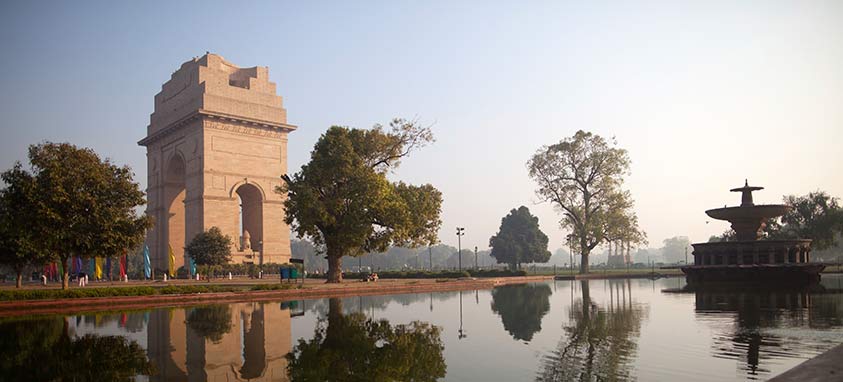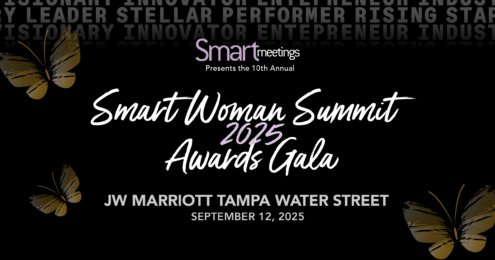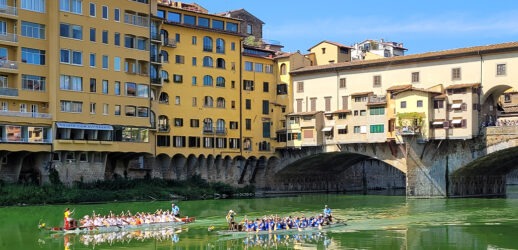International visitors can expect a royal welcome
India’s Ministry of Tourism says it right on its Facebook page: Atithi Devo Bhava (Guest is God). If you ask people who have been guests in India, they will tell you that although they might not have been treated exactly like deities, the experience came pretty close.
“The level of graciousness is unparalleled,” says Khadi Madama, a speaker and expert on India, who attended the 2009 International Congress of NRIs (non-resident Indians) presented by NRI Welfare Society and was given the Jewel of India Award. “I want to tell you, Indians know how to do things. They have everything organized down to the last T. They know how to make every single person, at every single one of their events, feel like a million dollars.”
If you’re thinking of bringing a conference to India, you can expect hospitality, attention, modern convention centers, Wi-Fi and one of the world’s most renowned tourist attractions. Not only can you see great historic structures, including the Taj Mahal, but you also can visit jungles, beaches, great cities, ruins and the sacred Ganges River.
On one side of the river you can see newly married couples bathing as part of a sacred ceremony; downstream you can see bodies being cremated, says Krishna Vegaraju, general manager at Travel Corporation India Ltd.
“You see life and death next to each other,” Vegaraju says. “If you don’t travel [here], you don’t experience that. It will make you start thinking about life: ‘What is life? What am I doing? How far will I come? What do I take back?’”
“Culture, nature, people, cuisine and our fabric shopping; you name it, we have it,” adds Vegaraju, who organizes conferences in India.
India and the United States are natural partners, since there already are so many Indians who come to the United States and vice versa. “A lot is happening from any point of view between the U.S. and India,” Vegaraju says.
Meeting planners will get more bang for their buck in India. In fact, conferences can run more than 20 percent less than for comparable conferences in the Unites States and Europe, he says.
There are some drawbacks, of course. But even the drawbacks can be seen as benefits.
For instance, India is thousands of miles from the United States. For some, that is a deterrent. But for others, it means the conference won’t be their only destination. They’ll come home with memories—perhaps even transcendent experiences. This is, after all, the birthplace of yoga and a place where people regularly travel for spiritual purposes.
India tends to operate at a slower pace, says Sriram Srinivasan, who worked for Deloitte in the southern India city of Hyderabad, and helped business people acclimate to the culture. That can be frustrating to Americans, he says. But the good news is that if you need anything done, you can generally hire someone in India at a very reasonable rate to handle it.
“India offers any meeting a great mix of history and modernity at the same time,” says Rajeev Kohli, joint managing director for Plan it! Meetings & Conferences, and president elect of the Society for Incentive Travel Excellence. “India offers venues from world-class convention centers to intimate palaces and forts, from up in the mountains to down by the beaches. Very few destinations offer such diversity with such a blend of amazing sensory experiences as India does.”
Here are three key meeting cities and features that are sure to wow attendees.

New Delhi
New Delhi is a district of Delhi, India’s capital and one of the world’s most ancient cities. It’s a large city with several distinct districts and plenty to do—including visiting museums and historical sites—to keep you busy when you’re not attending meetings. Delhi draws many conferences with its well-known venues, hotels and attractions.
Meeting Spaces & Hotels
Pragati Maidan is the country’s premier exhibition venue, featuring more than 770,000 sq. ft. of exhibition space. It offers 18 exhibition halls, four auditoriums and three open-air theaters. Vigyan Bhawan is a conference center with a plenary hall that can seat 1,285, as well as six smaller halls. The facility includes a business center, an exhibition hall and a media center.
Caparo Ayatti Cultural Centre, about 25 miles from New Delhi, is one of the most comprehensive convention centers in the country. With a capacity of 20,000 people, it offers 17 breakout rooms, cottages, a spa, a swimming pool, specialty restaurants and performance venues. It is located in Greater Noida, which boasts India’s only Formula One racing circuit.
Indira Gandhi Indoor Stadium is a fully air-conditioned hall with a seating capacity of 25,000. It’s ideal for culture shows and conferences. Talkatora Indoor Stadium is also air-conditioned, with a capacity of 3,035 people with exhibition facilities. It’s ideal for conventions, cultural festivals and sporting events.
Ashok Hotel has the largest pillarless convention hall in the country. It offers 550 guest rooms and can host events for up to 3,000.
Sightseeing
 Spice vendors at Chandni Chowk, Old Delhi
Spice vendors at Chandni Chowk, Old Delhi
Delhi features three UNESCO World Heritage Sites, including Humayun’s Tomb, which was built in 1570; it is an ode to Mughal architecture. Qutb Minar and its Monuments were built in the early 13th century. Red Fort Complex is named for the massive enclosing walls of red sandstone built as a palace fort for the fifth Mughal emperor of India.
Another must-see is Akshardham Temple, known for its splendid architecture. India Gate, an iconic and enduring symbol of New Delhi, was built to commemorate the 82,000 Indian and British soldiers who lost their lives during World War II.
Take a walk down Chandni Chowk, the main street of Old Delhi, where you’ll see firsthand the contrast of the old and new, with cars competing with animals and winding lanes filled with jewelry, fabric and electronic stores. Attendees also can visit Indira Gandhi Memorial Museum, the former home of the prime minister.
Mumbai
Mumbai, on India’s West Coast, is also known as Bombay. It is the country’s most populous city, with 18.4 million inhabitants. It has the most millionaires and billionaires of any city in India.
It also happens to have a tropical forest, hosts the film industry and is considered the fashion epicenter of India. In other words, you won’t get bored whether you want to dance or walk in nature.
Meeting Space & Hotels
Bombay Convention & Exhibition Centre boasts that it is the “largest and permanent exhibition center in the private sector in India.” It has four halls among its 484,375 sq. ft. of space. The center also features cafeterias and business communications centers.
Renaissance Mumbai Convention Centre Hotel offers 230,000 sq. ft. of meeting space, as well as more than 583 guest rooms. World Trade Centre, Mumbai, built in 1970, has office space, an expo center, more than 200 business occupants and 264,213 sq. ft. of meeting space.
Sri Shanmukhananda Fine Arts & Sangeetha Sabha is an auditorium with a seating capacity of more than 2,700. It also has a convention hall and conference hall that can accommodate 250.
Hotel Centre Point has a business center and meeting rooms in addition to 37 guest rooms, including eight luxury suites.
Sightseeing
Being the most metropolitan city in India, Mumbai is a great place to visit museums. National Gallery of Art, Mumbai, which opened in 1996, features the most significant collection of modern and contemporary art in the country.
Most attendees will want to take a Bollywood tour. Several of them will show you where films are produced. The Taj Mahal Hotel is a great place for tea even if you can’t afford a stay at the luxury property. Shree Siddhivinayak is an historic Hindu temple.
Take a drive along Marine Drive, a C-shaped road along the Arabian Sea. Colorful Crawford Market offers enticing shopping and food tours.
Hyderabad
Hyderabad, the capital of the South Indian state Telangana, is home to many temples, churches and bazaars, as well as high-tech companies. It is centrally located and easy to get to by many forms of transportation, which has helped Hyderabad cater to tourism. The mild climate also makes it a draw for worldwide meetings.
It also is home to Hyderabad Information Technology and Engineering Consultancy City, (HITEC City). The 151-acre business center is a major technology township where Google, Microsoft, Facebook, Oracle and IBM have offices.
Meeting Space & Hotels
Hyderabad International Convention Centre (HICC), a state-of-the-art meetings and events venue, features a convention hall that offers 66,200 sq. ft. of space and can be divided into six rooms. It holds up to 6,000 for receptions.
HICC has won the Best Convention Centre National Tourism Award from Incredible India for three years in a row. The center features modern IT infrastructure, design, technology and A/V equipment.
HICC is surrounded by five-star hotels, including Marriott Hyderabad Hotel and Convention Centre, which features 55,972 sq. ft. of event space and 293 guest rooms. ShilpakalaVedika is another state-of-the-art facility, with a 2,500-seat auditorium. Hotel Sitara Grand is a luxury five-star hotel with 154 guest rooms. It also includes six banquet halls.
Sightseeing
If you feel like a fun diversion, check out Ramoji Film City, a theme park popular among locals. It includes gardens, an eco-park and an extensive children’s area. Sanjay Gandhi National Park, located in the metropolitan area, is one of the most popular parks in the world, with 2 million visitors per year. It features 2,400-year-old caves.
If you love a bargain, head to Chor Market, a flea market that has anything and everything, including antiques, clothing and furniture.
Birla Mandir is a relatively new Hindu temple. It’s constructed from 2,000 tons of pure white marble and sits on a hill that offers amazing views.
Experience India
India features many museums, temples, parks and palaces. When meeting in India, the event space is world class and the offsite options are world renowned, so allow plenty of time for sightseeing.
“If you’re going to plan a meeting in India, you owe it to yourself to get out of the office,” Srinivasan says. “There’s so much to see and experience.”
Unforgettable India Experiences
“With the splendid Himalayan ranges in the north and an endless stretch of golden beaches in the south, India is a vivid kaleidoscope of landscapes, magnificent historical sites, royal cities, rich culture and incomparable hospitality,” states the India Convention Promotion Bureau website.
Being one of the world’s oldest civilizations, India boasts a fascinating amalgamation of traditional and contemporary.
Jaipur, known affectionately as the “Pink City,” is famous for the pink-colored stone used for construction. The story goes that in 1876, the Prince of Wales and Queen Victoria visited the city, and since pink is the color of hospitality, all buildings were painted to ensure a warm welcome. That tradition continues today.
Kingdom of Dreams, located in the golden triangle of Jaipur, Agra and Delhi, is an entertainment destination that features Indian arts, culture and technology wizardry. This complex is well-suited for product launches and private events. There’s also a theater that seats 300.
Kerala, on the southwest coast of India, is reverently called “God’s Own Country.” Besides natural beauty, the city’s nickname alludes to the many faiths that are practiced here, including Christianity, Hinduism, Islam and Jainism.
Travel Tips
Here are some tips to make sure your trip is as safe and fun as possible:
-Get used to being in crowds. If the stress of travel is getting to you, indulge in an Ayurvedic massage, an ancient, holistic practice.
-If visiting a temple, leave your footwear outside. Sandals are easy to slip on and off. Also, remove your shoes before entering someone’s home.
-Pack heavy-duty bug spray to defend against mosquitoes. You might also consider taking antimalarial medication.
-Before traveling by train, study the Indian Rail Time Table (indianrail.gov.in). Also, note that trains cars are typically marked off with gentlemen’s and ladies’ only sections.
-Master the art of bartering. One rule of thumb is to never pay more than half the initial asking price. But start negotiating at a quarter of the offered amount. Bartering is commonplace for everything from transportation to bazaar goods.
-Power cuts are common at certain times of the day; it is helpful to carry a mini flashlight. Also, India uses a two-pronged outlet, so be sure to bring a plug converter.
-Pay a few rupees to use public washrooms. Bring travel packs of toilet paper and hand disinfectant with you, just in case.
-Indians eat with their hands, but never the left hand (for reasons best left to the imagination).
-PDA is a no-no. While it is OK for men to hold hands, it is frowned upon to kiss or hug a member of the opposite gender in public.
-Watch what you eat and drink. Stick to bottled water and avoid peeled fruit and salads.
-Dress conservatively. Showing too much skin, including upper-arms and legs, is considered disrespectful, especially in sacred places.
-It is tempting to be generous with the poor. Donate instead to organizations because once you start giving out money, you might be swarmed.
-Take common-sense precautions.
Janet Kornblum is an award-winning journalist and media trainer who has written about everything from start-ups and science to business and celebrities for national publications.









